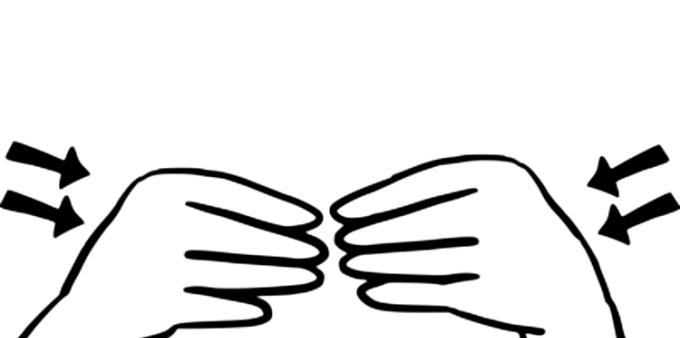Complete template of the whole vascular system in the body

After a series of medical measures they obtained a complete human vascular system profile.
Parents should teach children to learn to speak in sign language so that they can communicate with their baby from the early days as well as strengthen family affection even more.
Communication is an important part of your relationship with the little angel. Parents and babies can learn to communicate with hand signals before they babble their first voice. So why teach children to learn to speak with sign language and what are some tips to help them learn? Let's learn with aFamilyToday Health through the following article.
Baby sign language is a form of communication before a child can speak. Young children can understand visual cues even when they can't speak. After more than 7 months old, children will begin to let parents know how they feel, think and what they want.
Symbols are a way for children to express their wishes before their ability to speak better. Top experts have corroborated the benefits of sign language that stimulates brain development and enhances nerve building in the child's brain.
The best time you can teach your baby to learn to speak with sign language is when you watch your baby begin to express a desire to communicate. Your child will learn to sign before speaking, so this starts as soon as possible.
Some babies start learning simple signs at 6 months of age, but they may not be able to control their hands to give clear signals until 8-9 months. You can start teaching signs to your child when you think your child is ready to learn.
Communication becomes easier when your baby is able to express his or her needs. You should also talk while making signs so your baby knows how to relate those words to the signs.
Using gestures is part of conversation. Infants are smart enough to choose movements that connect with people. If you see your baby waving or lifting his hands to ask her to hold it, it is also a testament to how the baby has learned to sign.
The ability to understand language and gestures develops better than the baby's speaking ability. So your baby will use signs to help parents understand what they want.
It can be troublesome if you cannot understand what your child is asking for. Sign language can help parents in situations like these because their children are able to absorb them from an early age. Symbols will develop during the first 9 months while speech begins to reach around 12 months of age.
When you start to learn to speak, your baby has a lot of sign language. For example, a baby raised on a typical method will only speak about 10 from 18 months old. As for children taught sign language from a young age, they can speak 20 words as well as sign about 60 signs.
Sign language can instill a sense of confidence in your baby because parents can see their pride when they get what they want. For example, if a child signs that he wants a cookie and the adult responds to that desire, he or she will be happy and excited to repeat or practice other symbols.
When parents read picture books by making symbols, their children interact more than just reading through words. This method increases your baby's interest in books and eventually paves the way for early reading practice.
According to the study, children who listen to understand when taught sign language have better reading and writing skills and 12 points higher on IQ than those who use signs.
Teaching your child to learn sign language can improve the bond between parent and child. You will be like a friend teaching signs by interacting, talking, making eye contact and describing actions with your child. All of these will help the mother-child relationship become closer.
However, the benefits of using hand sign language are mostly only short-lived. Babies who use this method are sometimes more likely to communicate more easily, but most studies have shown that this ability does not last until the time they go to school. As your baby is able to speak and be understood, the benefits of using sign language will diminish and eventually disappear. Therefore, this language is only used for the main purpose of helping you to communicate better when your baby still cannot speak.
Start using sign language when your baby is interested in communicating with you - at least from 8 to 9 months because learning to communicate in sign language doesn't do any harm. communication habits later. Most babies will react within a time, usually between 10-14 months old.
Help your child develop sign language naturally and effectively. Any simple gesture that matches a word or sentence is effective (for example, waving your arm to describe the "bird" or scratching your underarm to describe "monkey"; folding your arms and tilting head means "go to sleep", rub your stomach when "hungry", curled your hand up to your mouth means "drink", your finger touching your nose means "smell").
Before you start teaching your child to become familiar with sign language, make a list of words you want your child to learn, then shorten this list and leave only words or ideas that can benefit the most from communication. together such as "eat", "hold". The most important signs that your baby needs to develop and learn will be the daily needs that your baby needs to express like hunger, thirst and fatigue.
By seeing the same symbols from day to day, your baby will quickly understand and imitate them.
To make sure your baby learns both sign language and spoken language, use both languages at the same time when talking with your baby.
Your baby will find it interesting when many people communicate with them using sign language. From siblings, grandparents to babysitters, anyone who spends a lot of time with the baby should at least understand the baby's most important signs.
Many babies invent their own symbols. If your baby likes to invent signs himself, use his own signs as their signs are often more meaningful to them.
It may take a few months for the baby to respond to the signs of the parents. However, not knowing how to make signs does not mean that you do not understand the meaning of the signs and words. Children simply cannot make signs and will have to work a lot before they are able to sign proficiently.
Once your baby starts to signal, he or she will use a variety of symbols if the parents are constantly teaching them new objects or phenomena.
Baby sign language inspires parents to speak clearly and with diverse expressions. Studies have also shown that variations in voice tones help children learn to speak faster. Therefore, you should practice with children to use sign language from an early age.
Signaling, like all forms of communication, should be developed spontaneously and in accordance with your baby's developmental pace. Children will learn most effectively through experiences, not through cumbersome instructions. If your child feels frustrated with signs, appears unwilling to use them, or feels overwhelmed, don't force him to learn.
Signs mentioning important people in a baby's life are all the more popular. Not only are children interested in using these signs, but adults are also interested in them. You can start with the following suggestions:
Teaching your baby to learn to speak in sign language related to food is also important so that she can signal to an adult that she is hungry. This helps children choose and request food from parents in the direction of building communication rather than creating confusion.
Milk is baby's first food. You may be breastfeeding or formula, or even both.
If you want to teach your baby to practice speaking in sign language with the word "breast milk", point to your chest and say "milk".
If you want to mention formula, you can cuddle your fingers to look like you are holding a bottle, then speak loudly and clearly for your baby to hear the word "milk".
Eating is also a basic word in everyday communication.
Bring the fingers of one hand together and point it into your mouth
Then, lightly touch your lips or point your hand to your mouth and say “eat”.

The word "more / more" is used in many cases because of its variety. To do this, simply cupping the fingers of both hands and gently touching each other.
Although sign language contains a lot of fun, sometimes parents feel anxious about how their baby responds or thinks to themselves that they have to teach them quickly. Here are a few things to keep in mind when teaching your baby to learn to speak in sign language:
Always having fun: Learning sign language is also part of the fun, parents will have memorable memories interacting with their baby.
Encouragement: Parents should reward their children with small gifts after they master a certain sign, not necessarily material but may be spiritual, such as reading to your baby a good story first when sleeping or cooking foods that your child likes.
Expansion of vocabulary: Just talk to your baby while doing the signs, you can absorb a lot of knowledge in the first year of life that not even the adults know.
Although sign language can make things easier when a baby cannot speak, sign language does not play a very important role in helping parents and babies communicate well, when parents and babies have a relationship has a good relationship with each other and can clearly understand each other through words. So if a formal sign language system doesn't make you feel comfortable or doesn't work for your baby, don't force yourself or your baby to use it. Parents can still guess what their baby wants without using sign language because parents are used to understanding their baby through their child's gestures and sounds.
Please refer to the article " 15 action games to practice skills to make children love to love " to practice more skills for your child.
aFamilyToday Health does not offer medical advice, diagnosis or treatment.
After a series of medical measures they obtained a complete human vascular system profile.
Watermelon is one of the fruits that many people love, not only cheap but also delicious, nutritious and refreshing in the summer. To get delicious watermelon pieces, show off your housewives, your artistic talents to cut beautiful pieces of watermelon.
The dog is an animal that is close to humans, it is also the first animal that humans were purebred, about 15,000 years ago at the end of the Ice Age.
aFamilyToday Health - The digestive system and body in each baby is different. Parents need to recognize notes to deal with when babies have a food allergy!
Babies need many factors for perfect development. aFamilyToday Health shares with parents things to keep in mind when babies are 8 weeks old so that parents can take care of their babies the best!
Babies need many factors for perfect development. aFamilyToday Health shares with parents things to keep in mind when babies are 18 weeks so that parents can take care of their babies the best!
Babies need many factors for perfect development. aFamilyToday Health shares with parents things to keep in mind when babies are 28 weeks old so that parents can take care of their babies the best!
Babies need many factors for perfect development. aFamilyToday Health shares with parents things to keep in mind when babies are 32 weeks old so that parents can take care of their babies the best!
aFamilyToday Health provides basic knowledge about 3 popular formula milk types, helping you to choose the right milk for your baby's needs.
In addition to giving babies the opportunity to enjoy valuable nutrition, what other interesting benefits can breastfeeding mothers enjoy?








